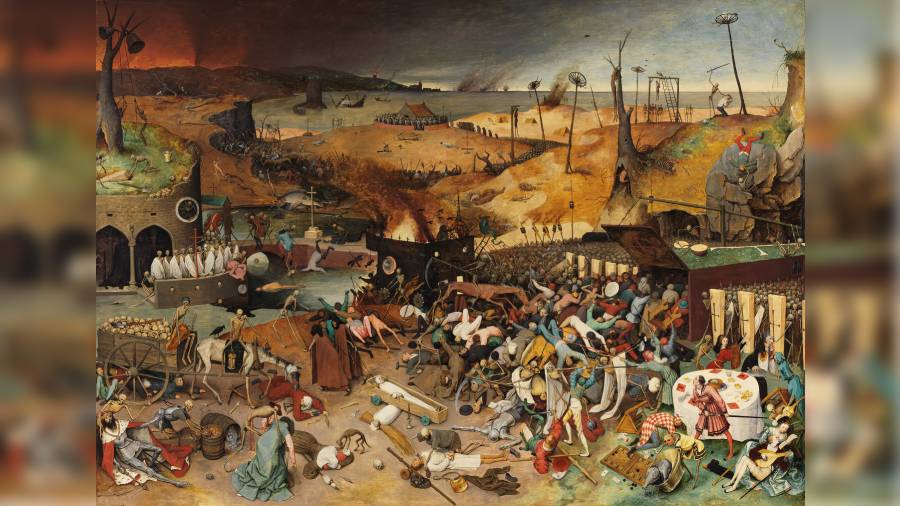In the mid-1300s, a species of bacteria spread by fleas and rats swept across Asia and Europe, causing deadly cases of bubonic plague. The Black Death is one of the most notorious pandemics in historical memory, with many experts estimating that it killed roughly 50 million Europeans, the majority of people across the continent.
“The data is sufficiently widespread and numerous to make it likely that the Black Death swept away around 60 per cent of Europe’s population,” Ole Benedictow, a Norwegian historian and one of the leading experts on the plague, wrote in 2005. When Benedictow published The Complete History of the Black Death in 2021, he raised that estimate to 65 per cent.
But those figures, based on historical documents from the time, greatly overestimate the true toll of the plague, according to a new study. By analysing ancient deposits of pollen as markers of agricultural activity, researchers from Germany found that the Black Death caused a patchwork of destruction.
“We cannot any longer say that it killed half of Europe,” said Adam Izdebski, an environmental historian at the Max Planck Institute for the Science of Human History in Jena, Germany, and an author of the new study.
In the 14th century, most Europeans worked on farms, which required intensive labour to yield crops. If half of all Europeans died between 1347 and 1352, agricultural activity would have plummeted. “Half of the labour force is disappearing instantly,” Izdebski said. “You cannot maintain the same level of land use. In many fields you would not be able to carry on.”
Losing half the population would have turned many farms fallow. Without enough herders to tend livestock, pastures would have become overgrown. Shrubs and trees would have taken over, eventually replaced by mature forests.
If the Black Death did indeed cause such a shift, Izdebski and his colleagues reasoned, they should be able to see it in the species of pollen that survived from the Middle Ages. Every year, plants release vast amounts of pollen into the air, and some of it ends up on the bottom of lakes and wetlands. Buried in the mud, the grains can survive sometimes for centuries.
To see what pollen had to say about the Black Death, Izdebski and his colleagues picked out 261 sites across Europe — from Ireland and Spain to Greece and Lithuania — that held grains preserved from around 1250 to 1450.
In some regions, such as Greece and central Italy, the pollen told a story of devastation. Pollen from crops like wheat dwindled. Dandelions and other flowers in pastureland faded. Fast-growing trees like birch appeared, followed by slow-growing ones like oaks.
But that was hardly the rule across Europe. In fact, just seven out of 21 regions the researchers studied underwent a catastrophic shift. In other places, the pollen registered little change at all.
In fact, in regions such as Ireland, central Spain and Lithuania, the landscape moved in the opposite direction. Pollen from mature forests became rarer, while pasture and farmland pollen became even more common. In some cases, two neighbouring regions veered off in different directions, with the pollen suggesting one turned to forest while the other turned to farms.
Although these findings suggest that the Black Death was not as catastrophic as many historians have argued, the authors of the new study did not offer a new figure for the real toll of the pandemic.
Some independent historians said the new, continent wide study agreed with their own research on particular European locales. For example, Sharon DeWitte, a biological anthropologist at the University of South Carolina, US, has found that skeletal remains from London during that period showed evidence of a modest toll from the pandemic. That made her wonder if the same was true for other parts of Europe.
“It’s one thing to have a reasonable suspicion and quite another to produce evidence, as these authors do,” DeWitte said. “It’s exciting.”
But other experts were not convinced by the new findings. John Aberth, author of The Black Death: A New History of the Great Mortality, said the study did not change his view that about half of Europeans across the continent died.
Aberth also questioned whether a region’s shift to crop pollen necessarily meant that the population there was booming. He speculated that people might have been wiped out by the Black Death only to be replaced by immigrants taking over the empty land.
Izdebski acknowledged that people were immigrating around Europe at the time of the bubonic plague. But he argued that their documented numbers were too small to replace half the population. “If you need hundreds of thousands of people to come in, where would they come from if everywhere, half of the population died?” he asked.
Monica Green, an independent historian based in Phoenix, US, speculated that the Black Death might have been caused by two strains of the bacteria Yersinia pestis, which could have caused different levels of devastation. Yersinia DNA collected from medieval skeletons hints at this possibility, she said.
In their study, Izdebski and his colleagues did not examine that possibility, but they did consider a number of other factors, including the climate and density of populations in different parts of Europe. But none accounted for the pattern they found.
NYTNS










